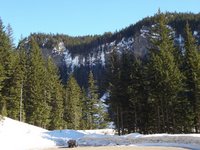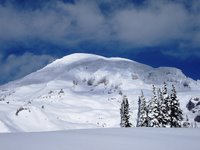Check out this 2x6 style of crevasse crossing. The image was snapped over the weekend (thankfully the board didn't)... The lumber has since been pulled, so now climbers must find another way around the crevasse. Here's more on the DC...
I received a few comments about the ice mass on the Muir Snowfield. Avid Rainier skier Ron Jarvis had this to say,
"When I started playing on Rainier in 1991 there were no dismounts required while skiing from Muir to Pebble in late summer/fall and as I recall that seemed to be the case right up until the last 2 or 3 years (dementia notwithstanding :-) ).
I would also add that similar conditions (volume/snow-ice depth) also seem to be the case on the contiguous neighbor to the east, the Paradise Glacier."



















